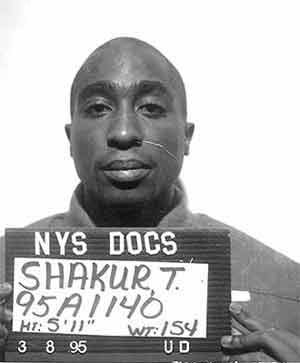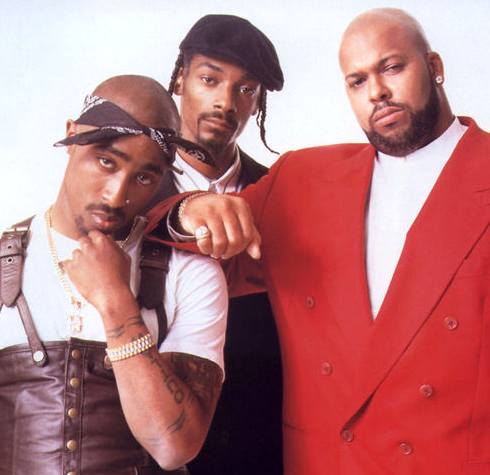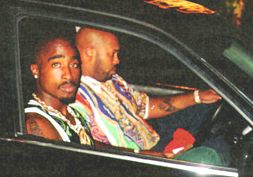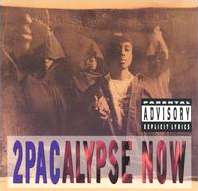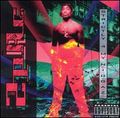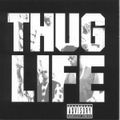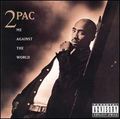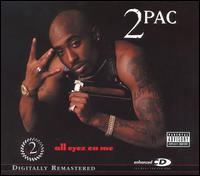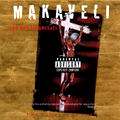Tupac in a police mugshot (March 8, 1995
Early career
His professional entertainment career began in early 1991, when he debuted his rap skills on the single "Same Song" from the Digital Underground album This is an EP Release. Also in 1991, he appeared in the music video for "Same Song" and made a brief appearance as himself in the movie Nothing But Trouble. In late 1991, after his rap debut, Tupac Shakur performed with Digital Underground again on the album Sons Of The P. Later that year, he released his first solo album, 2Pacalypse Now. Initially he had trouble marketing his solo debut, but Interscope Records executives Ted Field and Tom Whalley eventually agreed to distribute the record.
Shakur claimed his first album was aimed at the problems facing young black males, but it was publicly criticized for its graphic language and images of violence by and against police. In one incident, a young man claimed his killing of a Texas trooper was inspired by the album. Former Vice President Dan Quayle publicly denounced the album as having "no place in our society". 2Pacalypse Now did not do as well on the charts as future albums, spawning no top ten hits, and only being certified gold nearly 4 years later. His second album, Strictly 4 My N.I.G.G.A.Z., was released in 1993. Heavily produced by Stretch and the Live Squad, the album generated two hits, Keep Ya Head Up and I Get Around, the latter featuring guest appearances by other members of the Digital Underground crew. His sophomore album did better than his first, eventually going platinum.
Acting career
In addition to rapping, Shakur began acting in films. His first starring role was in the 1992 movie Juice as Bishop a trigger happy teen, in which he was hailed by Rolling Stone's Peter Travers as "the film's most magnetic figure." He went on to star in Poetic Justice (with Janet Jackson), Above the Rim, Gridlock'd (with Tim Roth), Bullet, and Gang Related. He had also been slated to star in the Hughes brothers' Menace II Society but was replaced by Larenz Tate after assaulting the directors. Director John Singleton claimed that he wrote the film Baby Boy with Shakur in mind for the leading role. It was eventually filmed with Tyrese Gibson in his place and released in 2001, five years after Shakur's death. The movie features a mural of Shakur in the protagonist's bedroom as well as featuring "Hail Mary" in the movie's score.
Thug Life
In late 1993, Shakur formed the group Thug Life with a few of his friends, including Big Syke, Macadoshis, his step-brother Mopreme Shakur, and Rated R. The group released their first and only album Thug Life: Thug Life Vol. 1 on September 24, 1994. The group usually did their concerts without Shakur.
Legal issues
Even as he garnered fame as a rapper and actor, Shakur gained notoriety for his conflicts with the law. On October of 1991 he filed a $10 million lawsuit against the Oakland Police Department, alleging they brutally beat him over a jaywalking incident. The suit was later settled for $42,000.
In October 1993, in Atlanta, Shakur shot two off-duty police officers (one in the leg, one in the buttocks) that were harassing a black motorist. Charges against Shakur were dismissed when it was discovered that both officers were intoxicated and were in possession of stolen weapons from an evidence locker during the incident.
In December 1993, Shakur was charged with sexually abusing a woman in his hotel room. According to the complaint, Shakur sodomized the woman and then encouraged his friends to sexually abuse her. Shakur vehemently denied the charges. He had prior relations days earlier with the woman who was pressing the charges against him. She performed oral sex on him on a club dance floor and the two had later had sex in his hotel room. The allegations were made after she revisited his hotel room for the second time where she engaged in sexual activity with his friends and claimed Tupac's entourage had gang-raped her, saying to him while leaving, "How could you do this to me?" Tupac states he had fallen asleep shortly after she arrived and later awoke to her accusations and legal threats. He later said he felt guilty for leaving her alone, and did not want anyone else to go to jail, but at the same time did not want to go to jail for a crime he didn't commit. Shakur was convicted of "sexual abuse (forcibly touching the buttocks)". There is much controversy to the ruling of the case, the judge said that he did not think Tupac was guilty but sentenced him because of all of Shakur's recent run-ins with the law. There was no semen found at the scene or any evidence this incident occurred. On February 14, 1995, he was sentenced to one and a half years to four and a half years in prison.
In 1994, he was convicted of attacking a former employer while on a music video set. He was sentenced to 15 days in jail with additional days on a highway work crew, community service, and a $2000 fine. In 1995, a wrongful death lawsuit was brought against Shakur in the 1992 shooting of six-year-old Qa'id Walker-Teal of Marin City, California. The child had been the victim of a stray bullet in a shootout between Tupac's entourage and a rival group, though the bullet was not from Tupac's gun. Criminal charges were not sought, and Shakur settled with the family for an amount estimated between $300,000 and $500,000. After serving part of his sentence on the sexual abuse conviction, he was released on bail pending his appeal. On April 5, 1996, a judge sentenced him to serve 120 days in jail for violating terms of probation.
The November 1994 shooting
On the night of November 30, 1994, the day before the verdict in his sexual abuse trial was to be announced, Shakur was shot five times in the lobby of the Quad Recording Studios in Manhattan by two black men in an apparent robbery attempt. He would later accuse Puff Daddy and Notorious B.I.G. — whom he saw after the shooting — of setting him up. According to the doctors at Bellevue Hospital, where he was admitted immediately following the incident, Shakur was shot five times. He checked out of the hospital, against doctor's orders, three hours after surgery. The day following the incident, December 1, 1994, Shakur entered the courthouse in a wheelchair and was found guilty of three counts of sexual abuse, but innocent of six others, including sodomy.
Prison sentence
Shakur began serving his prison sentence at Clinton Correctional Facility in February 1995. Shortly afterwards, he released his multi-platinum album Me Against the World. Shakur is the only artist ever to have an album at number one on the charts while serving a prison sentence. The album debuted at number-one and stayed there for five weeks and first week sales of 240,000 copies which was the record for highest first week sales for a solo male rap artist at the time. He married his long-time girlfriend, Keisha Morris, while serving his sentence. This marriage was later annulled. While in prison Tupac read many books by Niccolo Machiavelli, Sun Tzu's The Art of War and other works of political philosophy and strategy. He also wrote a screenplay titled Live 2 Tell while incarcerated.
In October 1995, Shakur's case got an appeal but due to all of Shakur's legal fees he could not raise the $1.4 million bail. After serving eleven months of his one and a half year to four and a half year sentence, Shakur was released from prison, due in large part to the help and influence of Marion "Suge" Knight, CEO of Death Row Records. Knight posted $1.4 million bail pending appeal of the conviction, in exchange for which Shakur was obligated to release three albums for the Death Row label.


 LinkBack URL
LinkBack URL About LinkBacks
About LinkBacks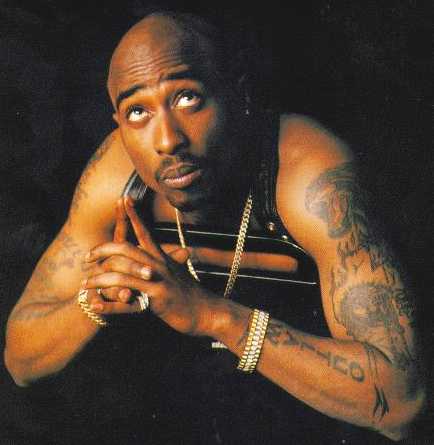





 Rispondi citando
Rispondi citando